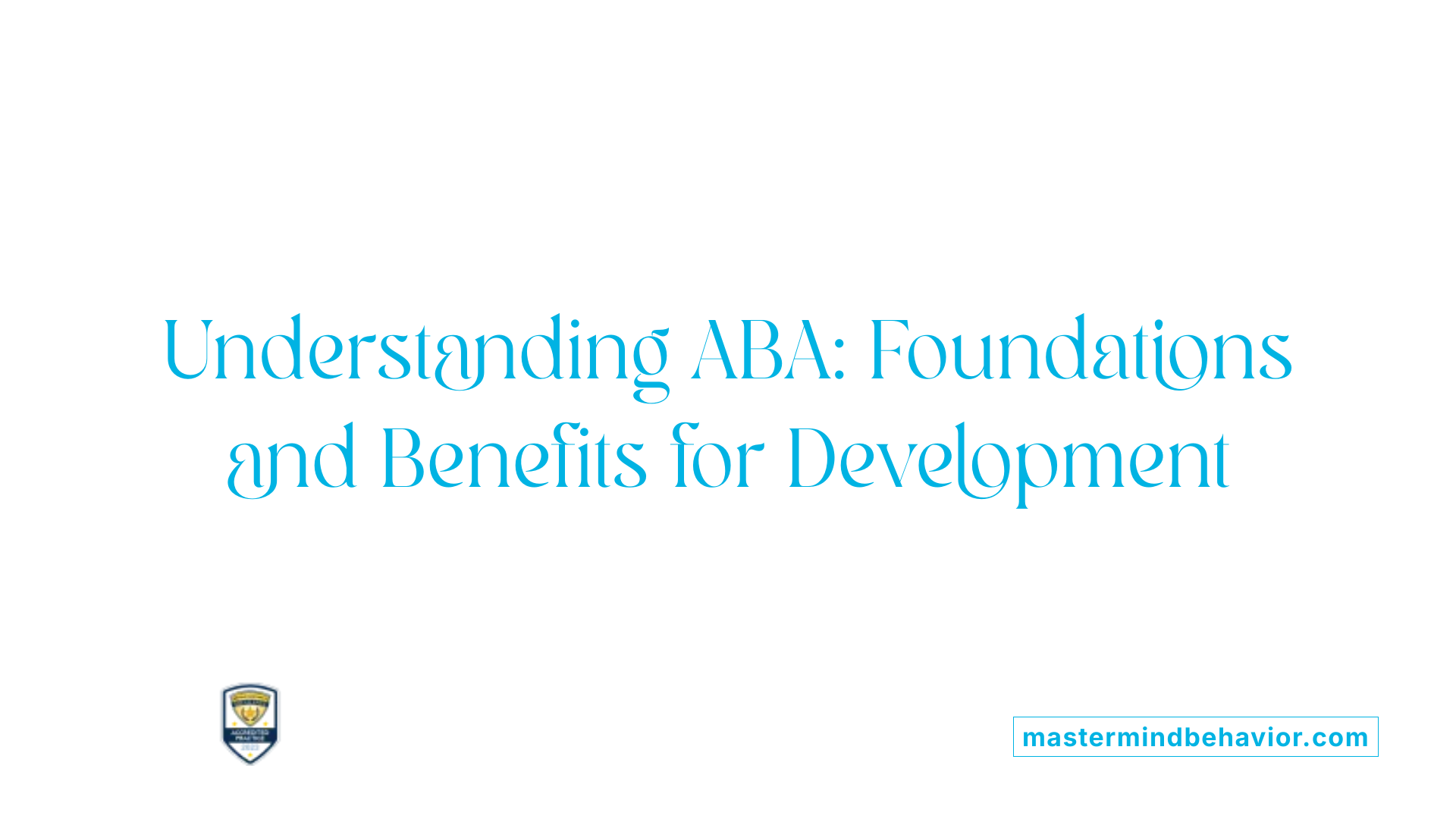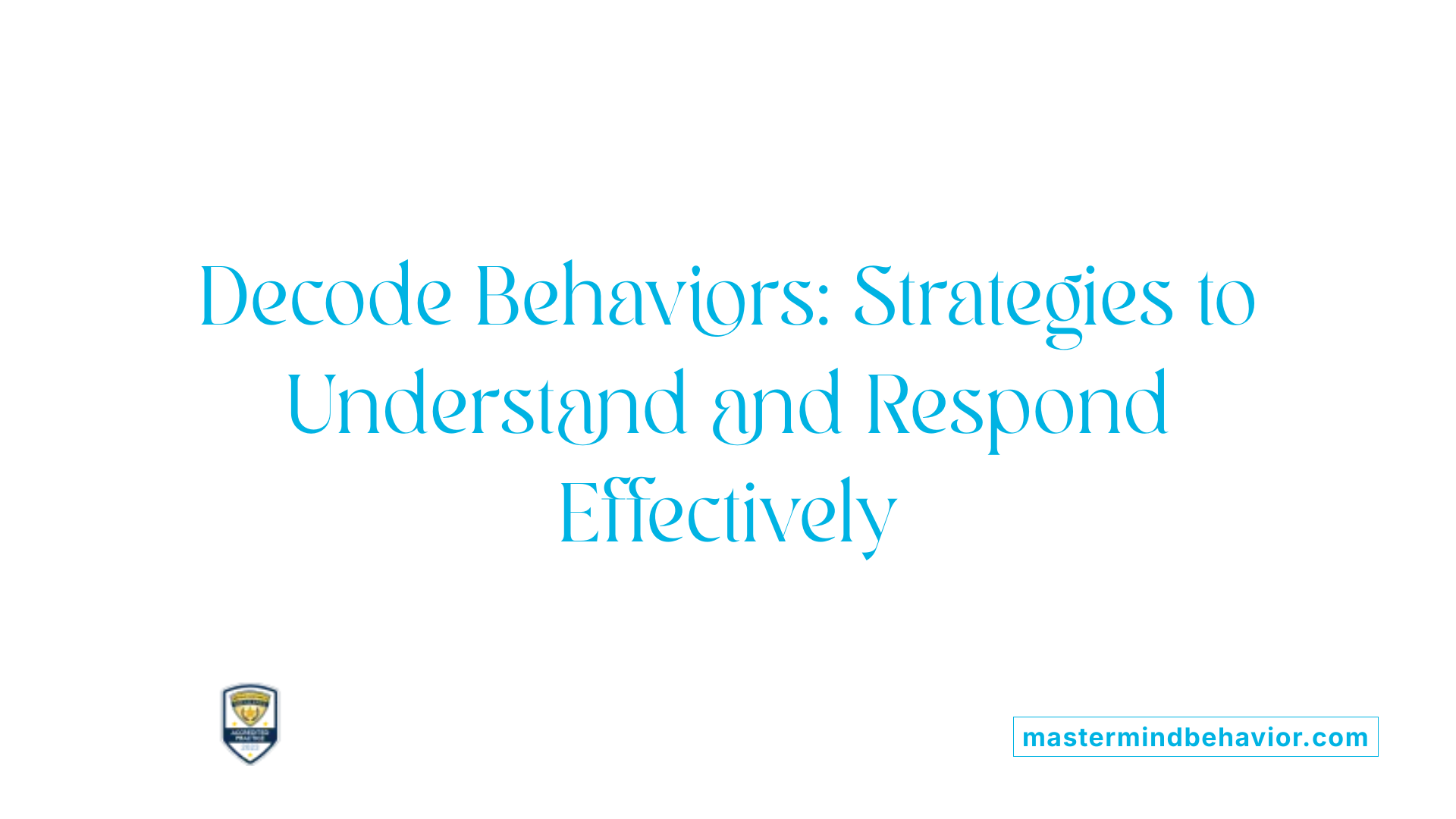Understanding the Impact of ABA on Family Dynamics and Child Development
Applied Behavior Analysis (ABA) is a scientifically backed approach that has transformed how parents comprehend and support their child's behaviors. By offering a structured, data-driven framework, ABA helps families gain insights into the motivations behind challenging behaviors and develop effective strategies to foster positive change. This comprehensive overview explores the vital role of ABA in enhancing parental understanding, outlining techniques used in therapy, and emphasizing the importance of family involvement for successful outcomes.
Demystifying ABA: Foundations and Benefits

What is ABA and its core principles?
Applied Behavior Analysis (ABA) is an evidence-based approach that focuses on understanding how behavior is influenced by the environment. It involves systematically applying techniques to increase helpful behaviors and decrease non-beneficial ones. The core techniques include positive reinforcement—rewarding desired behaviors to encourage their repetition—and functional assessments, which help identify triggers and the purpose behind behaviors.
ABA programs are highly personalized, developed based on a detailed assessment of a child's strengths, challenges, and preferences. Therapists—often Board Certified Behavior Analysts (BCBAs)—design goals that cover areas such as communication, social skills, self-care, academic skills, and independence. The overarching objective is to foster meaningful improvements in the child's overall functioning and quality of life.
How ABA improves children’s social, communicative, and adaptive skills
ABA primarily aims to develop essential skills that support a child's ability to participate effectively in daily life. It enhances communication through techniques like modeling, prompting, and reinforcement, enabling children to express needs and feelings more clearly.
Social skills are targeted systematically with structured methods such as discrete trial training and social stories. These teach behaviors like sharing, taking turns, and understanding social cues, which promote positive peer interactions.
Besides communication and social abilities, ABA helps children acquire practical life skills—routines for hygiene, dressing, and self-care. It also emphasizes independence, developing self-management, emotional awareness, and problem-solving skills.
Standardized interventions include breaking tasks into smaller steps, creating visual supports such as schedules, and encouraging the generalization of skills across settings—home, school, and community—to ensure functional application in real life.
The scientific evidence supporting ABA effectiveness
ABA is recognized as an effective treatment by major health organizations such as the US Surgeon General and the American Psychological Association. Extensive research demonstrates that ABA can produce significant improvements in cognition, language, adaptive behaviors, and social skills in children with autism.
Studies show that about 64% of children with autism receive ABA therapy, which is associated with better developmental outcomes. Practitioners use data collection to monitor progress continuously, allowing rapid adjustments to intervention strategies to maximize benefits.
Furthermore, ABA's focus on measurable outcomes and scientific rigor helps ensure that interventions are both effective and tailored to each child's evolving needs.
| Aspect | Description | Supporting Evidence |
|---|---|---|
| Behavioral improvement | Reduces problem behaviors like tantrums, aggression, and self-injury | Multiple research studies over decades |
| Communication skills | Enhances expressive and receptive language skills | Recognized by the US Surgeon General |
| Social interactions | Teaches social cues, sharing, turn-taking, and appropriate responses | Evidenced by peer-reviewed trials |
| Academic success | Supports learning in classroom environments | Case studies and controlled research |
| Life skills | Builds independence in daily routines and self-care | Long-term outcome studies |
How does ABA therapy help parents understand their child's behaviors?
ABA therapy helps parents better understand their child's behaviors by providing them with strategies to interpret and respond appropriately. It involves comprehensive assessments that identify specific behaviors and their underlying functions, enabling parents to recognize triggers and motivations.
Through personalized intervention plans, parents learn positive reinforcement techniques and effective behavior management strategies. ABA also emphasizes parent training, empowering families to implement consistent support at home.
Overall, this approach fosters improved communication, enhances behavior, and strengthens family interactions by fostering a clearer understanding of the child's needs and behaviors.
What techniques are used in ABA therapy to help parents interpret their child’s behaviors?
ABA employs various techniques to assist parents in understanding their child's behaviors. Modeling allows parents to observe and imitate appropriate responses, while prompting offers hints or cues to encourage desired behaviors. Reinforcement provides positive consequences to strengthen beneficial behaviors.
Shaping involves reinforcing successive approximations toward a more complex behavior, which helps parents guide their children's development gradually. Functional assessments identify why behaviors occur, offering insight into underlying needs or triggers.
Additionally, Naturalistic Developmental Behavioural Interventions (NDBIs) use child-initiated activities, natural cues, and routine interactions to promote learning in natural environments. Parents play a vital role by applying these strategies during everyday moments, making therapy relevant and effective.
These techniques collectively enhance parents' understanding and responsiveness, supporting ongoing skill development and positive behavior changes in children.
Structured Assessments and Personalized Goals
How are initial assessments conducted to understand a child's behavior?
In ABA therapy, the process begins with a comprehensive evaluation called a functional assessment. This assessment involves gathering detailed information about the child's behaviors, environmental factors, and possible triggers. Certified behavior analysts (BCBAs) observe and interview caregivers and teachers to identify the functions of problematic behaviors, such as attention seeking or sensory stimulation.
The goal of these assessments is to pinpoint the underlying causes of challenging behaviors, which guides the development of tailored interventions. Data from these evaluations provide a baseline that helps in setting realistic and specific goals for therapy.
How are individual intervention plans created?
Once the assessment phase is complete, the BCBA designs an individualized intervention plan. This plan focuses on targeted skills like communication, social interaction, self-care, and reducing problematic behaviors. It includes clear, measurable objectives tailored to each child's developmental level, strengths, and interests.
The intervention strategies combine various ABA techniques such as positive reinforcement, prompting, shaping, and skill acquisition protocols. The plan also incorporates preferences and motivations of the child to increase engagement and effectiveness.
Why is ongoing data collection and progress monitoring important?
Data collection is fundamental to ABA therapy. Therapists continually track the child's responses to interventions using precise measurement tools. Regular data analysis reveals whether behaviors are improving, stable, or worsening.
Monitoring progress through graphs or charts allows therapists and parents to see trends over time. If data indicate that goals are not being met, intervention strategies can be adjusted promptly. Frequent review meetings ensure that the therapy remains personalized and effective.
| Step | Activity | Focus Area | Details |
|---|---|---|---|
| 1 | Initial Functional Assessment | Understand behavior functions | Observation, interviews, environmental analysis |
| 2 | Development of Intervention Plan | Tailored goals and strategies | Based on assessment, incorporating child preferences and strengths |
| 3 | Data Collection & Progress Monitoring | Measure effectiveness of interventions | Daily logs, graphs, mobility tracking; review sessions to adjust strategies |
How can ABA principles be applied to support parent-child interactions at home?
ABA principles can be effectively applied to support parent-child interactions at home by incorporating strategies such as positive reinforcement to encourage desirable behaviors and improve communication. Parents can use prompting and modeling techniques, along with visual supports like schedules and communication boards, to help children learn new skills within their daily routines.
Structuring consistent routines and breaking down complex tasks into smaller, manageable steps makes learning more accessible and engaging for children receiving ABA therapy. Involving family members and collaborating with professionals ensures that interventions are tailored to the child's needs and that parents are trained to implement strategies consistently.
This approach promotes generalization of skills, enhances family dynamics, and helps children acquire important life skills while fostering positive, supportive relationships at home.
Parent Training and Skill Development

Why is parent training important in ABA therapy?
Parent training plays a vital role in the success of ABA therapy for children with autism and other behavioral challenges. It provides parents with the knowledge and tools they need to actively support and reinforce their child's learning outside of therapy sessions.
Through dedicated training sessions, parents learn to implement evidence-based strategies consistently at home. This consistency helps children transfer skills learned during therapy into everyday situations, promoting generalization and stability of positive behaviors.
Training also focuses on helping parents understand the functions behind their child's behaviors. Recognizing triggers and motivations allows parents to respond appropriately, using techniques like positive reinforcement to encourage desirable actions and gently redirect or reduce harmful behaviors.
Effective communication and collaboration between parents and therapists ensure that interventions are tailored to the child's specific needs. Regular skill-building sessions empower parents to feel confident in managing behaviors, setting routines, and establishing clear expectations.
Parental involvement is associated with improved therapy outcomes. When parents are well-trained, they can maintain structure and consistency across all settings—home, school, and community—creating a cohesive support network for the child.
Moreover, parent training boosts confidence, advocacy skills, and stress management. Equipped with effective strategies, parents become strong advocates for their children, improving not only behavioral outcomes but also strengthening family bonds.
How training supports behavior management and skill reinforcement
Training provides parents with practical skills to manage challenging behaviors and reinforce positive ones. Techniques such as prompting, modeling, and applying visual supports are taught during parent sessions.
Parents learn how to collect data on behaviors, which helps monitor progress and guide adjustments in interventions. They are also taught how to set achievable goals, deliver consistent consequences, and utilize reward systems effectively.
As a result, children experience a more predictable environment, reducing anxiety and increasing motivation to learn new skills.
Building confidence and advocacy skills for parents
Parent training enhances confidence by demystifying ABA principles and showing parents how to practically apply them.
Parents gain advocacy skills by understanding how to communicate effectively with educators, therapists, and other professionals. This ensures their child's needs are met and that interventions remain consistent across settings.
By participating in sessions, parents develop problem-solving abilities, enabling them to address emerging challenges proactively.
Most importantly, this empowerment helps create a stronger parent-child relationship, based on shared understanding and active collaboration.
| Aspect | Focus | Outcome |
|---|---|---|
| Training Sessions | Skill-building, behavior management | Parents learn to implement strategies, reinforce positive behaviors |
| Data collection & Progress Monitoring | Understanding and tracking behaviors | Data-informed adjustments, better outcomes |
| Confidence & Advocacy | Communicating, problem-solving | Empowered parents advocate effectively, foster stronger bonds |
| Support Networks | Parent groups, resource sharing | Reduced isolation, shared experiences |
This integrated approach of education, practice, and ongoing support fosters a proactive, confident parenting style that directly benefits the child's developmental journey.
Techniques and Strategies for Behavior Interpretation

What techniques are used in ABA therapy to help parents interpret their child’s behaviors?
ABA therapy utilizes a variety of strategies to enable parents to better understand and respond to their child's behaviors. One fundamental technique is modeling, where parents learn to imitate appropriate responses demonstrated by therapists. This helps parents recognize and replicate positive interactions, fostering consistent reinforcement at home.
Prompting is another useful method, which involves giving hints or cues to encourage desired behaviors. Prompts can be verbal, gestural, or physical and are gradually faded as the child masters the behavior. Reinforcement, a cornerstone of ABA, involves offering positive consequences such as praise, toys, or preferred activities to strengthen specific behaviors.
Shaping is a process where complex behaviors are developed through reinforcing successive approximations. For example, a parent might reward a child's small steps toward a bigger goal, like improving eye contact or phrase expression.
Functional assessment plays a critical role by helping identify the purpose or function behind behaviors. Understanding whether a behavior is seeking attention, avoiding a task, or sensory-driven guides parents to respond effectively.
In addition to these foundational techniques, Naturalistic Developmental Behavioural Interventions (NDBIs) incorporate child-initiated teaching moments, using natural cues and routine activities. These methods promote learning in natural settings, making behaviors more meaningful and generalizable.
Parents are actively involved in implementing naturalistic strategies during regular activities like play, mealtime, or outings. This hands-on involvement boosts skill development and promotes consistent support across different environments.
Altogether, these ABA techniques help parents interpret behaviors with clarity, enabling them to respond appropriately, reinforce positive actions, and support overall development. Regular training sessions, observation, and guided practice strengthen parents' confidence and efficacy in behavioral management.
Creating Consistent Environments and Promoting Generalization
How does ABA therapy support parents in managing and responding to their child's behaviors?
ABA therapy plays a crucial role in helping parents understand and manage their child's behaviors effectively. It provides straightforward, accessible information rooted in the science of behavior, focusing on how environment influences actions. Central to ABA are strategies like positive reinforcement, which rewards desirable behaviors, and understanding the ABCs—antecedents (triggers), behaviors, and consequences—that shape behavior.
Parents are equipped with detailed reference guides that explain these concepts clearly, helping them grasp how specific actions and environmental factors can influence their child's responses. Through personalized training, they learn how to set measurable goals, observe behaviors, and track progress with data collection and graphing techniques. This systematic approach enhances parents' ability to support their child's development consistently.
Active participation in the therapy process—such as involvement in assessments, goal-setting, and ongoing data review—enables parents to tailor strategies that suit their child's unique needs. They learn how to implement interventions at home and in the community, reinforcing positive behaviors and diminishing challenging ones.
When parents understand the principles behind ABA, they become confident advocates and active collaborators. This shared approach ensures behaviors are generalized across different settings, including home, school, and public environments. As a result, children benefit from consistent support, making it more likely that new skills will be retained and applied in various aspects of their lives.
Moreover, training programs empower families to respond calmly and appropriately to behaviors, promoting emotional security for children. The outcome is a more cohesive, supportive environment where positive behaviors are reinforced regularly, leading to improved social, communication, and daily living skills.
Ultimately, ABA not only supports skill development but also strengthens the parent-child bond. When parents are equipped with the right tools and understanding, they can create a stable, predictable environment that fosters resilience and independence in their children.
| Aspect | Description | Supporting Strategies |
|---|---|---|
| Consistent routines | Essential for stability and predictability | Establish daily schedules with visual supports |
| Behavior management | Responding effectively to behaviors | Use clear, calm instructions and reinforcement |
| Skill generalization | Applying skills across settings | Practice behaviors in different environments with varied people |
| Collaboration | Working with schools and community | Share strategies and progress reports with educators |
| Parental training | Enhancing skills at home | Participate in workshops, use follow-up resources |
By integrating these practices, parents can foster an environment where children feel secure and motivated to learn, ultimately supporting their growth and independence.
Family Involvement and Emotional Support

What are the benefits of family-centered ABA approaches?
Family-centered ABA approaches involve actively engaging parents and caregivers in the therapy process. This collaboration leads to a deeper understanding of the child's behaviors, triggers, and needs, equipping families with essential knowledge.
When parents are involved, interventions can be implemented consistently across various settings such as home, school, and community. This consistency helps children generalize learned skills more effectively, enhancing their overall progress.
Empowering parents through education and participation increases their confidence in managing their child's behaviors. This active involvement fosters a sense of partnership and shared responsibility, ultimately leading to better treatment outcomes.
Shared therapeutic activities and routines help strengthen the emotional bond between parents and children. Participating in therapy sessions and practicing strategies at home creates opportunities for quality time,which supports emotional security.
Support networks and community resources are vital components of a family-centered approach. Connecting families with support groups, online forums, and local resources provides emotional encouragement, practical advice, and a sense of community.
These networks also facilitate the exchange of experiences and strategies among families facing similar challenges, reducing feelings of isolation. Access to community programs and resources helps families sustain long-term progress beyond therapy sessions.
In summary, family-centered ABA approaches foster improved communication, social skills, and adaptive behaviors in children. They also enhance family well-being by reducing stress and creating a collaborative environment for ongoing development.
| Aspect | Benefits | Additional Details |
|---|---|---|
| Emotional Security | Builds emotional bonds and trust | Sharing activities boosts attachment and comfort |
| Consistency | Promotes skill generalization | Reinforces learning across settings |
| Parent Confidence | Increases skills and advocacy | Parents become effective at applying learned strategies |
| Support Networks | Reduces isolation and emotional burden | Community resources and peer support |
| Treatment Outcomes | Improves overall progress | Better communication, social skills, and independence |
| Family Well-being | Reduces stress and fosters resilience | Ongoing support and collaborative planning |
Adopting a family-centered approach involves more than just therapy sessions; it incorporates continuous communication, shared goal-setting, and active participation in every stage of the child's development. This holistic method ensures families are well-equipped, emotionally supported, and involved, creating a nurturing environment that significantly benefits the child's growth and family dynamics.
Science and Efficacy of ABA in Family Contexts

What is the scientific basis and effectiveness of ABA therapy in family contexts?
Applied Behavior Analysis (ABA) is founded on well-established scientific principles of behavior analysis. It primarily uses reinforcement, environmental modifications, and the ABC (Antecedent, Behavior, Consequence) model to understand and shape behavior. These core techniques enable therapists to identify what triggers certain behaviors, how behaviors are maintained, and how new, positive behaviors can be encouraged.
Research supports the effectiveness of ABA in significantly improving a child's social, communication, and daily living skills, particularly for children diagnosed with autism spectrum disorder (ASD). Extensive studies, including multiple controlled trials and meta-analyses, have demonstrated that structured ABA programs can lead to meaningful gains in adaptive functioning. These improvements often include better language use, social interactions, and independence.
Involving families in ABA therapy enhances its success. Family participation ensures consistent application of strategies across different settings, helping children generalize skills learned in therapy to everyday life. It also empowers parents and caregivers to act as active partners, reinforcing positive behaviors and reducing problematic ones in the home environment.
The duration and intensity of intervention are critical factors in achieving optimal results. Evidence suggests that programs running for at least 12 to 24 months with sufficient therapy hours tend to produce more substantial and lasting improvements. Early intervention, especially when started at a young age, can maximize developmental gains, though ABA also benefits older children, adolescents, and even adults.
Despite its proven effectiveness, some challenges exist, such as ensuring high fidelity in implementing interventions, maintaining access to qualified providers, and determining optimal dosing for each child. These factors highlight the importance of a thorough, family-centered approach that adapts to each child's unique needs.
Overall, ABA remains the gold standard for behavioral intervention in autism, supported by a broad body of scientific research. When delivered within a comprehensive, family-inclusive framework, ABA can foster substantial improvements in a child's skills and overall quality of life.
| Aspect | Details | Additional Notes |
|---|---|---|
| Scientific basis | Reinforcement, ABC model, environmental manipulation | Grounded in behavior analysis research |
| Research evidence | Controlled trials, meta-analyses | Shows improvements in cognitive, language, adaptive skills |
| Importance of early intervention | Initiating therapy early yields better outcomes | Especially effective within the first few years of life |
| Ongoing monitoring | Regular data collection and program adjustments | Ensures individualized and effective intervention |
| Family involvement | Reinforces skill generalization and consistency | Essential for maximizing therapy benefits |
| Duration | 12 to 24 months or longer | Longer programs generally produce greater gains |
| Challenges | Access, intervention fidelity, individual variability | Need for trained professionals and adaptable plans |
This cumulative research underscores the importance of scientifically grounded, family-centered ABA therapy. Its adaptability and proven results make it a vital component of behavioral treatment for children with ASD, with benefits extending across various areas of development and family well-being.
Nurturing Progress Through Consistency and Collaboration
Incorporating ABA therapy into family life offers a pathway to a deeper understanding of children’s behaviors, empowering parents to become active, confident participants in their child's developmental journey. By leveraging targeted techniques, collaborative goal-setting, and ongoing data analysis, families can support meaningful progress while strengthening bonds and fostering resilience. The success of ABA in family contexts underscores the importance of education, consistency, and shared effort, ultimately creating an environment where children can thrive and families can flourish together.
References
- Helping Parents Understand Applied Behavior Analysis: Creating a ...
- ABA Therapy in Center: How Involving Parents Makes a Difference
- 7 Surprising Benefits of ABA Therapy for Kids You Need to Know
- Applied Behavior Analysis (ABA) | Autism Speaks
- What Parents Need to Know About ABA Therapy for Autism
- The Role of Family in ABA Therapy: Tips for Parents
- Behavioral Parent Training: Important Tips and Strategies | Regis









